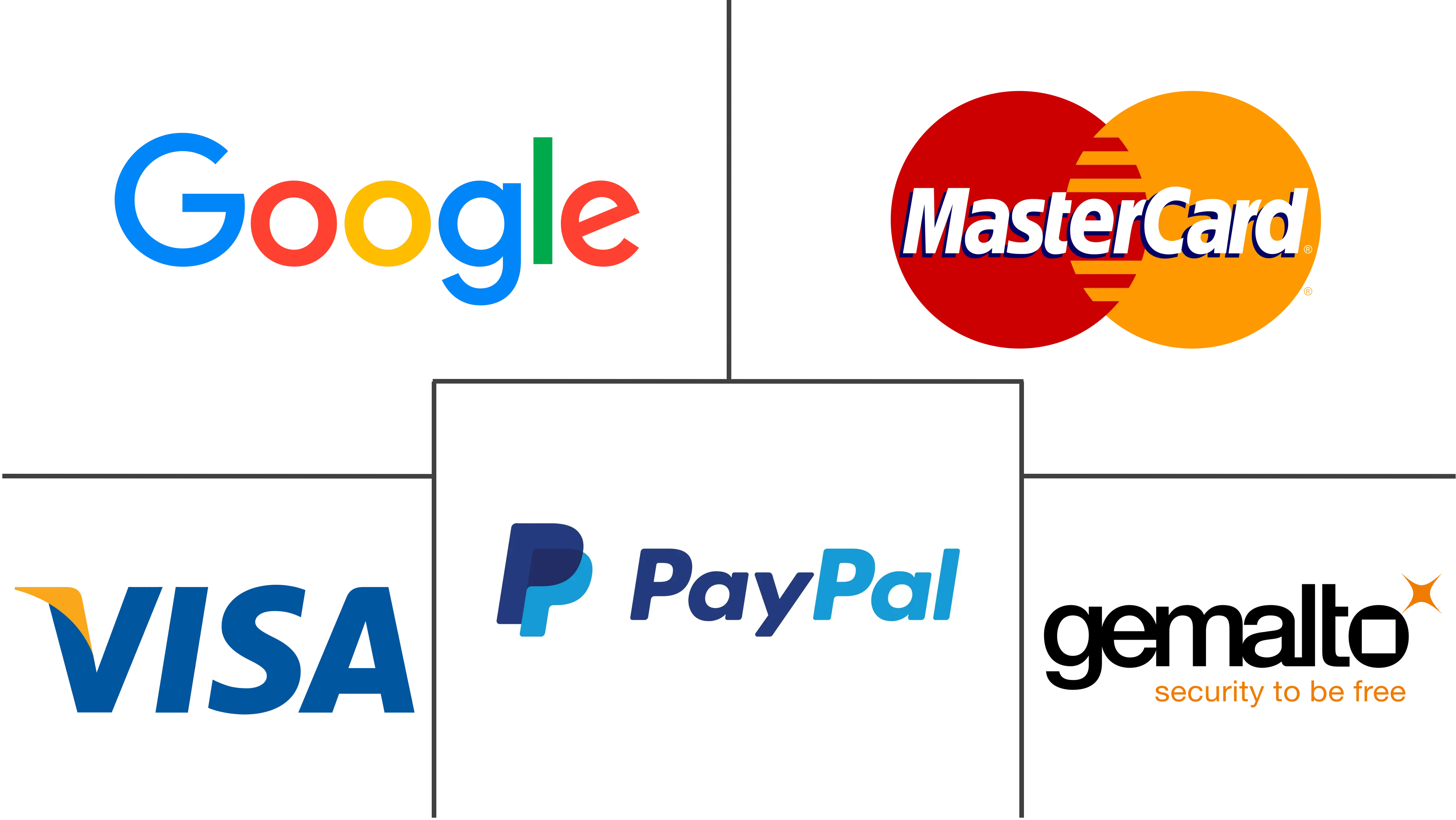Mobile Commerce Market Size and Share
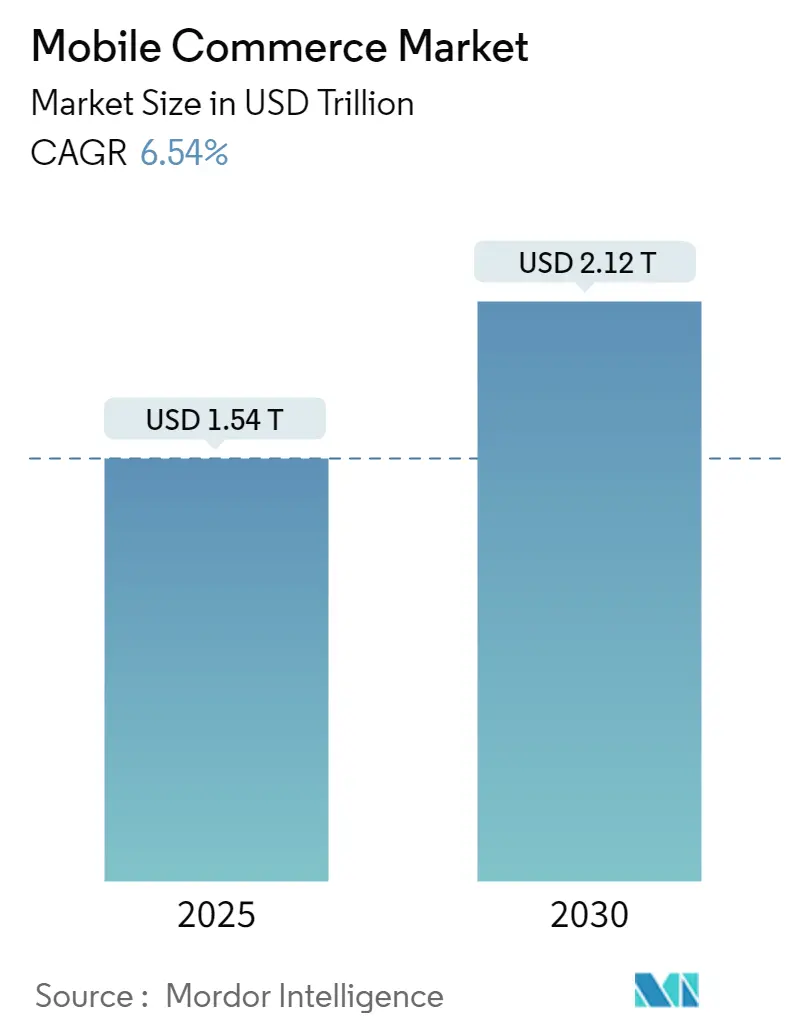
Mobile Commerce Market Analysis by Mordor Intelligence
The Mobile Commerce Market size is estimated at USD 1.54 trillion in 2025, and is expected to reach USD 2.12 trillion by 2030, at a CAGR of 6.54% during the forecast period (2025-2030).
Mobile commerce, also known as m-commerce, refers to the buying and selling goods & services through wireless handheld devices like smartphones, tablets, and other mobile devices. It is a subset of electronic commerce (e-commerce) and is typically conducted using apps or mobile-optimized websites. It enables users to perform online transactions anywhere and anytime, as long as they have access to the internet. It has become increasingly popular in recent years because of the widespread usage of mobile devices. A significant advantage of m-commerce is that it allows businesses to reach a broader audience. With mobile apps, companies can get more people and make their buying experience more straightforward.
- Mobile commerce can involve various payment methods, such as credit/debit cards, mobile wallets, and carrier billing. E-commerce websites are optimized for mobile devices to provide a better user experience and make it easy for customers to browse & shop using their mobile devices.
- Large-format wholesalers and offline retailers are stepping up and changing their efforts to serve customers online and build omnichannel models to meet the increasing demand for essential groceries and foods. According to India Brand Equity Foundation (IBEF), e-commerce is growing exponentially. The market value of the e-commerce industry in India is estimated to reach USD 350 billion by 2030. The increase in the Ecommerce sector is expected to offer lucrative opportunities for the growth of the studied market.
- Mobile billing has become increasingly popular in recent years, making it easier for consumers to shop and pay for goods and services without relying on cash or credit cards. It can be used for various transactions, including online shopping, bill payments, and banking. The convenience, security, and flexibility of mobile billing will likely drive the growth of the studied market.
- On the flip side, one of the restraining factors for the mobile commerce market is the availability of cyber thieves, which can threaten the security of mobile transactions. Other factors that may restrain mobile commerce market growth include limitations in the development of mobile technology, as well as consumer concerns about information and service quality and perceived privacy protection.
- In a world of ascending inflation, the war in Ukraine, and the remnants of the COVID-19 pandemic, many facets of the global world impacted eCommerce. Among them, the most prominent are inflation and a disturbed supply chain infrastructure. The increasing inflation was anticipated to force customers to cut back on nonessential products.
Global Mobile Commerce Market Trends and Insights
Growth of Smartphones And Internet Penetration Is Anticipated To Drive The M-commerce Market
- Smartphones have become more advanced, offering features such as high-quality cameras, larger storage capacity, and longer battery life. Further, with the introduction of budget smartphones, the prices have become more affordable for a more significant percentage of the population. Such factors are contributing to the increasing global penetration of smartphones. For instance, by the end of 2023, the total number of mobile subscriptions globally was expected to reach around 1.6 billion and is poised to increase further, according to Ericsson forecasts.
- The commercialization of 5G boosts global trends in the market studied. For instance, the transition toward 5G accelerates the demand for advanced mobile devices. According to the Ericsson Mobility Report 5G mobile subscriptions were anticipated to reach around 5 billion by 2028. Further, during the same period, the 5G population coverage is estimated to be 85%, while 5G networks are anticipated to carry around 70% of mobile traffic.
- Moreover, according to the China Academy of Information and Communications Technology (CAICT), Chinese 5G mobile phone shipments reached nearly 19.52 million, accounting for 80.1% of the country's total mobile phone shipments. Further, 20 new 5G mobile phone models were released in the country, up 25% year-on-year during the month. The increasing penetration of 5G is anticipated to boost the smartphone industry's growth, enhancing the demand for the studied market.
- Additionally, the increasing internet penetration significantly impacts the mobile commerce market. With more people accessing the internet, mainly through mobile devices, there has been a surge in online shopping and mobile transactions. According to Great Works Internet, as of April 2023, Northern Europe ranked first by the internet penetration rate, with approximately 97% of its population using the internet. Western Europe followed, with 93.5%. Overall, the global average internet penetration rate was around 64.6%.
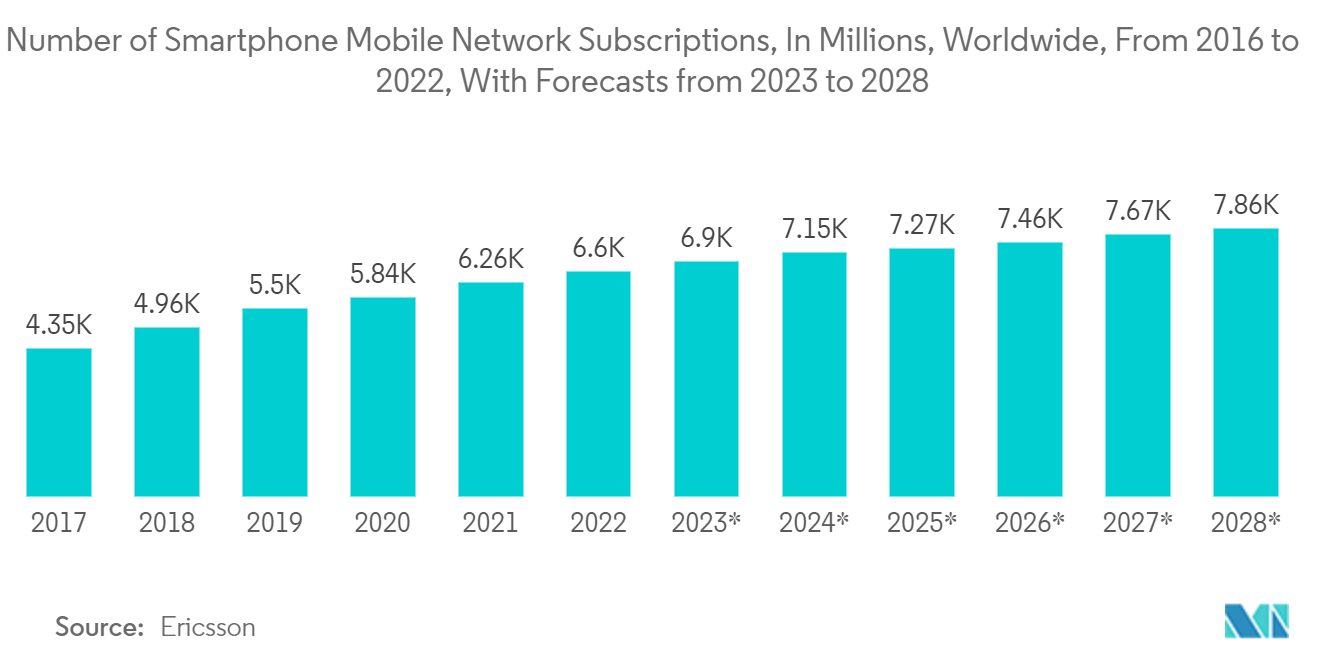
North America Is Anticipated To Hold The Largest Market Share
- In the United States, the rising smartphone penetration and mobile internet usage are driving the growth of mobile commerce. Also, personalized marketing and the availability of multichannel & mobile commerce options have encouraged consumers to make purchases using their mobile devices.
- According to GSMA, in North America, the number of smartphone subscribers is estimated to reach 328 million by the year 2025. Further, by 2025, the region is expected to witness an increase in Internet penetration rates (80%) and mobile subscribers (86%). The increasing demand for mobile phones is likely to provide lucrative opportunities for the growth of the studied market.
- Further, according to Great Works Internet, as of 2023, approximately 92% of individuals in the United States accessed the Internet. The United States is one of the biggest online markets worldwide, and in 2022, there were over 299 million internet users in the country.
- The region is also witnessing an upsurge in the adoption of E-commerce owing to several factors like the increasing dominance of e-commerce giants like Amazon & eBay, the ability of e-commerce to provide a wider selection of products than brick-and-mortar stores, and offers competitive pricing due to lower overhead costs. The ease of finding and comparing products online and the advances in technology, like improved website design and faster shipping options, are also contributing to the development of E-commerce in the region.
- For instance, according to the US Census Bureau, in the first quarter of 2023, the share of e-commerce in total U.S. retail sales stood at 15.1%, an increase from the previous quarter (14.8%). From January to March 2023, retail e-commerce sales in the United States reached approximately USD 273 billion, the highest quarterly revenue in history.
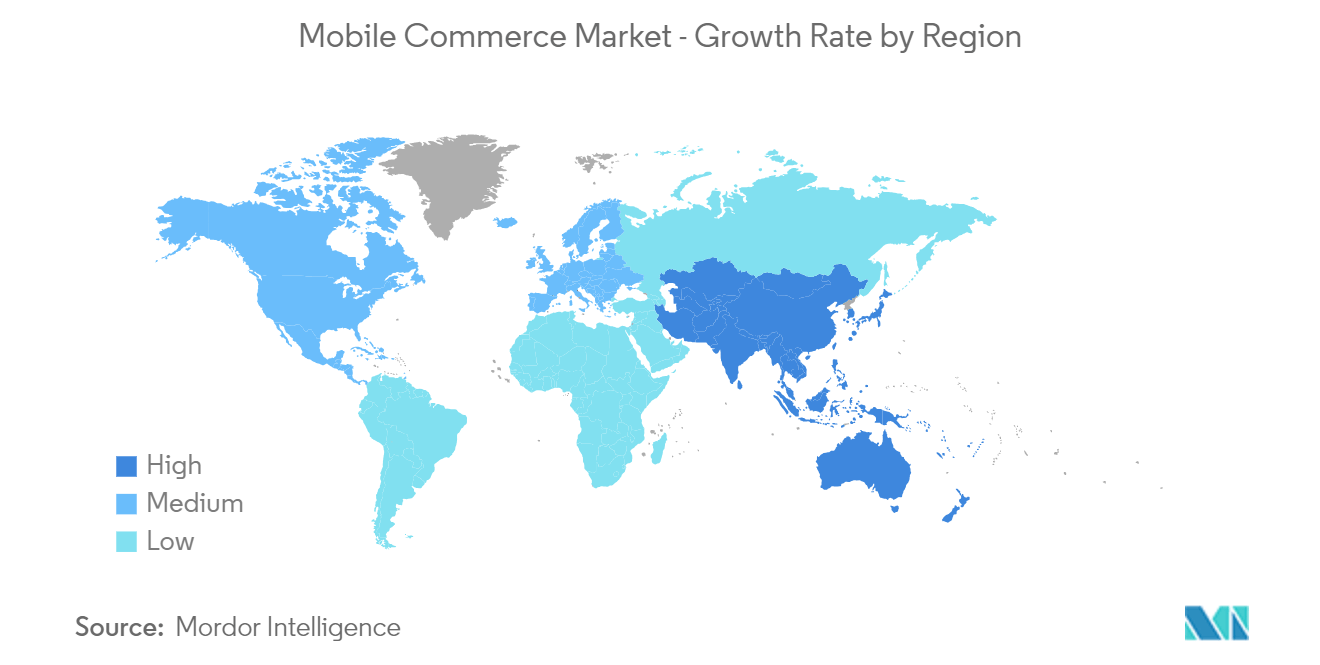
Competitive Landscape
The mobile commerce market is fragmented due to the growing adoption of digitization, e-commerce, and m-commerce, making people use these mediums more often, giving the players a broad scope to penetrate the market with technological innovation and developments. Some key players include Ericsson, Gemalto (Thales Company), Google Inc., IBM Corporation, Mastercard Inc., Paypal Holding, SAP SE, and Visa Inc., among others.
- October 2023: To invest in GenAI startups focused on payments, fintech, and commerce, Visa announced the launch of a USD 100 million generative AI (GENAI) venture fund. The initiative will be led by Visa Ventures, a corporate investment arm of the global payment giant that has invested and cooperated with related companies since 2007.
- March 2023: MobiKwik, which deferred its November 2021 initial public offer (IPO) due to choppy markets, announced its plans to go public in the next 12-18 months. In 2022, it raised over INR 50 crore in debt funding. In 2023, the company is looking at being fully profitable on an INR 1,000 crore topline.
Mobile Commerce Industry Leaders
-
Google Inc.
-
Thales Group (Gemalto NV)
-
Mastercard Inc.
-
Paypal Holding Inc.
-
Visa Inc.
- *Disclaimer: Major Players sorted in no particular order
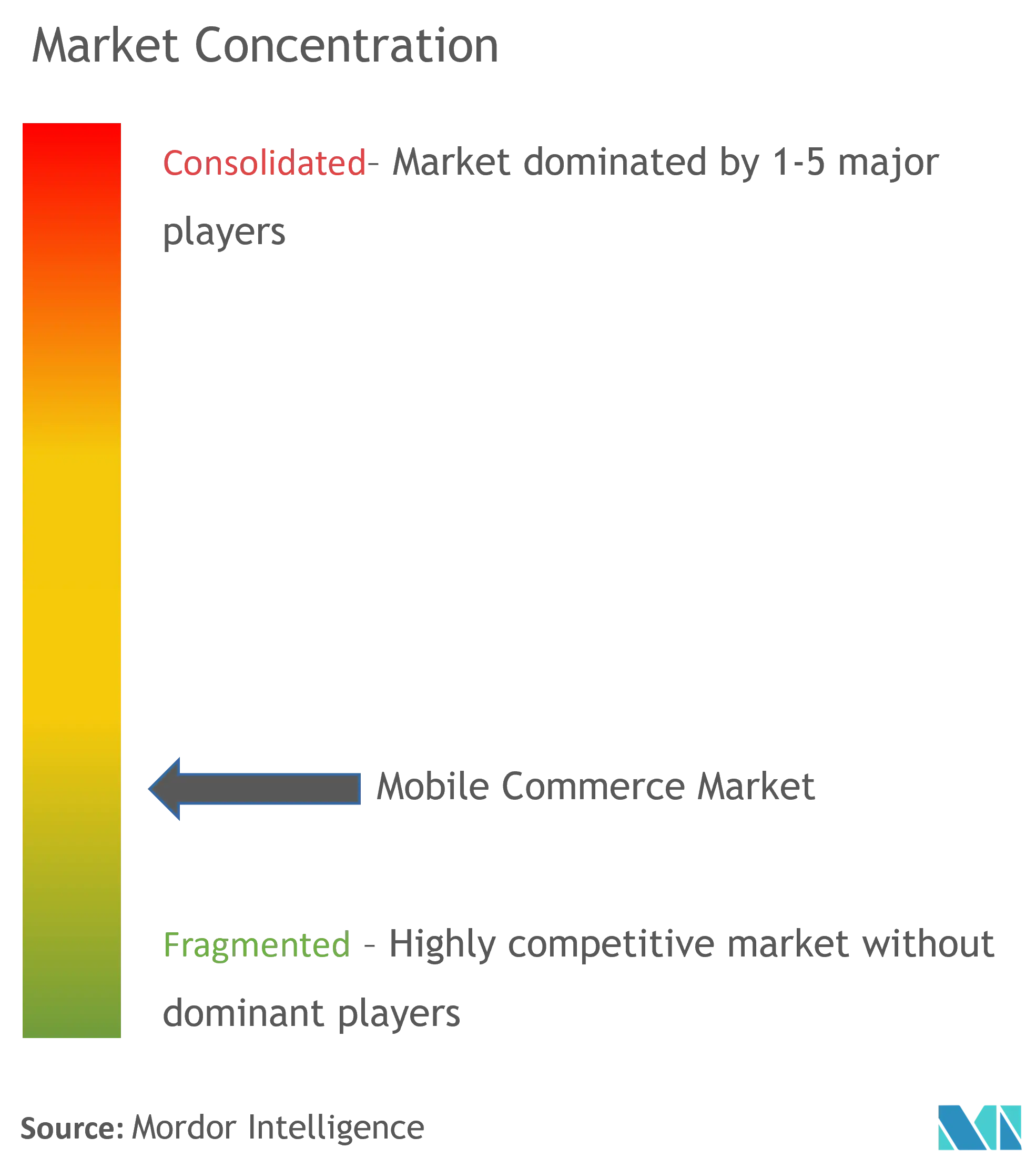
Recent Industry Developments
- September 2023: Ericsson announced the company’s strategy to create a global network platform business with network APIs. A commercial partnership has been formed between Ericsson and Deutsche Telekom to provide developers and enterprises with communication and network APIs. The central part of the Ericsson enterprise strategy is to build a Global Platform for exposing advanced 5G capabilities, e.g., quality on demand, speed, latency, and location via simple use of Network APIs. This will make it easier for developers and businesses to integrate network features in their applications, accelerating the digitization of enterprises and creating new opportunities for operators to derive revenue from these investments.
- March 2023: Amazon Business announced the launch of 3-Way Match on the Amazon Business mobile app to help customers improve their innovative business-buying strategies and automate reporting. With the new 3-Way Match app, mobile devices can be used by account administrators and authorized buyers to check the barcode on packages when they are delivered so that an item is marked as received without delay. With this new feature, a simple and quick way to close purchase orders anywhere anytime is available for nearly 1 million active Amazon Business mobile app users in the U.S. at no additional cost.
Global Mobile Commerce Market Report Scope
Mobile commerce (m-commerce) is an e-commerce where buying and selling goods and services are conducted through wireless handheld mobile devices. It includes mobile phones, smartphones, smartwatches, tablets, and netbooks. M-commerce allows users to access online shopping platforms without needing a desktop computer. M-commerce includes mobile banking, in-app purchasing, virtual marketplace apps like the Amazon mobile app, or digital wallets such as Google Pay, Apple Pay, Android Pay, and Samsung Pay.
The mobile commerce market is segmented by transaction type (m-retailing, m-ticketing/booking, m-billing), payment modes (near field communication, premium SMS, wireless application protocol, direct carrier billing), and geography. The market sizes and forecasts are provided in terms of value (USD) for all the above segments.
| M Retailing |
| M Ticketing/Booking |
| M Billing |
| Other Transaction Types |
| Near Field Communication (NFC) |
| Premium SMS |
| Wireless Application Protocol (WAP) |
| Direct Carrier Billing |
| Other Payment Modes |
| North America | United States |
| Canada | |
| Europe | United Kingdom |
| Germany | |
| France | |
| Rest of Europe | |
| Asia-Pacific | China |
| Japan | |
| India | |
| Rest of Asia-Pacific | |
| Latin America | Brazil |
| Argentina | |
| Rest of Latin America | |
| Middle-East and Africa | UAE |
| Saudi Arabia | |
| Rest of Middle-East and Africa |
| By Transaction Type | M Retailing | |
| M Ticketing/Booking | ||
| M Billing | ||
| Other Transaction Types | ||
| By Payment Mode | Near Field Communication (NFC) | |
| Premium SMS | ||
| Wireless Application Protocol (WAP) | ||
| Direct Carrier Billing | ||
| Other Payment Modes | ||
| Geography | North America | United States |
| Canada | ||
| Europe | United Kingdom | |
| Germany | ||
| France | ||
| Rest of Europe | ||
| Asia-Pacific | China | |
| Japan | ||
| India | ||
| Rest of Asia-Pacific | ||
| Latin America | Brazil | |
| Argentina | ||
| Rest of Latin America | ||
| Middle-East and Africa | UAE | |
| Saudi Arabia | ||
| Rest of Middle-East and Africa | ||
Key Questions Answered in the Report
How big is the Mobile Commerce Market?
The Mobile Commerce Market size is expected to reach USD 1.54 trillion in 2025 and grow at a CAGR of 6.54% to reach USD 2.12 trillion by 2030.
What is the current Mobile Commerce Market size?
In 2025, the Mobile Commerce Market size is expected to reach USD 1.54 trillion.
Who are the key players in Mobile Commerce Market?
Google Inc., Thales Group (Gemalto NV), Mastercard Inc., Paypal Holding Inc. and Visa Inc. are the major companies operating in the Mobile Commerce Market.
Which is the fastest growing region in Mobile Commerce Market?
Asia Pacific is estimated to grow at the highest CAGR over the forecast period (2025-2030).
Which region has the biggest share in Mobile Commerce Market?
In 2025, the North America accounts for the largest market share in Mobile Commerce Market.
What years does this Mobile Commerce Market cover, and what was the market size in 2024?
In 2024, the Mobile Commerce Market size was estimated at USD 1.44 trillion. The report covers the Mobile Commerce Market historical market size for years: 2019, 2020, 2021, 2022, 2023 and 2024. The report also forecasts the Mobile Commerce Market size for years: 2025, 2026, 2027, 2028, 2029 and 2030.
Page last updated on:
Mobile Commerce Market Report
The global mobile commerce (m-commerce) market is experiencing a remarkable surge, attributed to the widespread adoption of smartphones and the internet, alongside advancements in mobile technology for banking and payments. This growth is propelled by the convenience and cost-effectiveness of mobile transactions, establishing m-commerce as a crucial component of the e-commerce sector. With a shift towards mobile-based payments, including retailing, ticketing, and billing, the market is segmented by transaction types, payment modes, and user demographics, with the Asia Pacific region leading due to its booming e-commerce industry and high smartphone usage. Innovations like NFC for contactless payments and AI-driven personalization are enhancing user experiences, despite challenges such as logistics and regulatory compliance. The competitive landscape is focused on optimizing user experience and expanding globally. M-commerce statistics from Mordor Intelligence™ Industry Reports highlight a robust growth trajectory, with detailed market share, size, and revenue growth rate analysis, offering a forecast outlook and historical overview. For comprehensive insights, a free report PDF download is available, providing a sample of this industry analysis.
